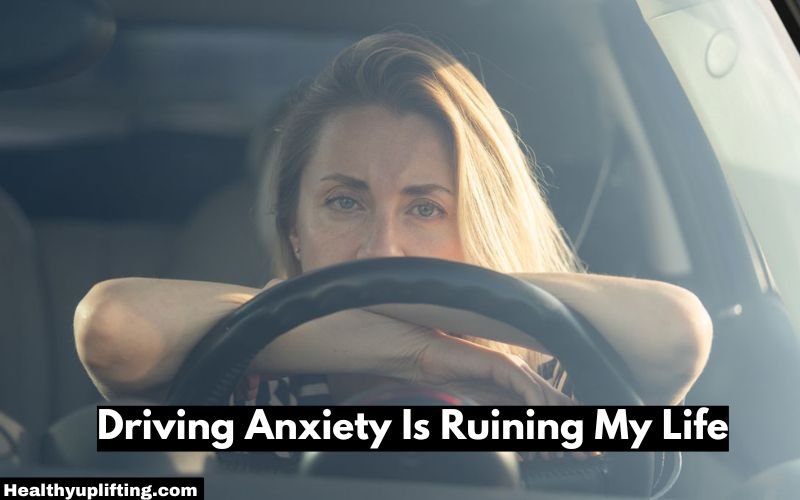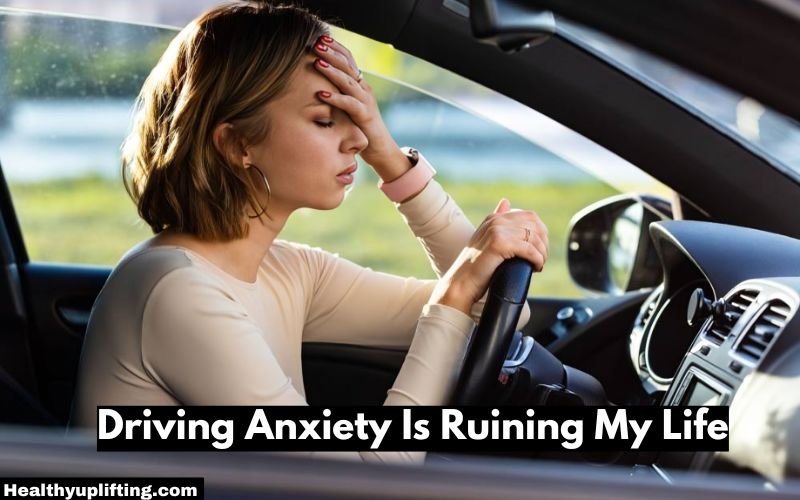Driving is a routine task for many people, but for those struggling with driving anxiety, it can feel like a terrifying and overwhelming experience. The fear of driving can significantly interfere with daily life, making it hard to commute to work, visit friends, or run essential errands. If you’ve found yourself thinking, “Driving anxiety is ruining my life,” you are not alone.
Many people experience this condition, and with the right strategies, it’s possible to overcome this fear and regain control over your driving experience. In this article, we will explore the causes of driving anxiety, practical solutions to reduce fear, and tips for safe traveling to help you manage and overcome this challenging condition.
What is Driving Anxiety?
Driving anxiety refers to intense fear, nervousness, or discomfort when driving or even thinking about driving. This fear can range from mild unease to full-blown panic attacks, and it can stem from different triggers, such as specific road situations (e.g., highways, bridges, tunnels) or a generalized fear of losing control while behind the wheel.
Symptoms of Driving Anxiety include:
- Increased heart rate and rapid breathing
- Sweating, shaking, or trembling hands
- Tightness in the chest or feeling faint
- Dizziness, nausea, or lightheadedness
- Difficulty concentrating
- Panic attacks or avoidance of driving altogether
Causes of Driving Anxiety
Understanding the causes of driving anxiety is the first step in addressing the issue. Some common causes include:

- Past Traumatic Experiences: A significant cause of driving anxiety is a history of traumatic experiences while driving or being in a car. This could be a car accident, witnessing a collision, or even narrowly avoiding an accident. These incidents can create a fear response in your brain, making driving a trigger for anxiety.
- Fear of Losing Control: Some individuals fear losing control while driving, whether it’s losing control of the vehicle or experiencing a panic attack while on the road. This fear can lead to an overwhelming sense of dread, particularly in situations where a quick reaction is needed (e.g., merging on highways, sudden stops).
- Environmental Triggers: Specific environments can trigger anxiety, such as driving on highways, over bridges, in tunnels, or during bad weather. These scenarios can heighten feelings of vulnerability and stress.
- Lack of Experience or Confidence: New drivers or those who haven’t driven in a while may experience driving anxiety due to a lack of confidence or experience. The fear of making mistakes or not knowing how to handle different driving situations can lead to heightened anxiety.
- Underlying Mental Health Conditions: Generalized anxiety disorder (GAD), panic disorder, or other mental health issues can exacerbate driving anxiety. When anxiety is present in multiple areas of life, driving becomes another situation where anxious thoughts and fears can manifest.
- Pressure or Expectations: Many people feel the societal pressure to be perfect drivers, adding unnecessary stress. Expectations from others to drive fast or handle challenging driving conditions can create anxiety, especially for individuals who are naturally more cautious.
Solutions for Managing Driving Anxiety
Overcoming driving anxiety requires a multi-faceted approach, combining mindset shifts, coping mechanisms, and gradual exposure to driving situations. Here are several effective solutions:
- Exposure Therapy: One of the most effective treatments for anxiety-related conditions is gradual exposure therapy. This involves slowly exposing yourself to the thing you fear, in this case, driving. Start with low-pressure driving situations, such as driving on quiet streets or in parking lots. Gradually, as your confidence builds, increase the complexity of the driving scenarios.
- Cognitive Behavioral Therapy (CBT): CBT is another effective therapy that helps individuals identify and challenge negative thought patterns that lead to anxiety. By changing the way you think about driving, you can reduce your fear response. Working with a therapist specializing in CBT can help you reframe your thoughts and learn coping strategies to manage anxiety.
- Relaxation Techniques: Learning relaxation techniques can help you stay calm while driving. These include deep breathing exercises, progressive muscle relaxation, and mindfulness meditation. Practicing these techniques before and during driving can help regulate your nervous system and prevent panic attacks.
- Take Defensive Driving Courses: Defensive driving courses can equip you with the skills to feel more confident behind the wheel. By learning techniques to handle emergencies, avoid accidents, and navigate difficult driving situations, you will be better prepared and more confident.
- Use Positive Affirmations: Repeating positive affirmations can help retrain your brain to associate driving with calmness and safety. Examples of positive affirmations include: “I am a capable and safe driver,” “I can handle any situation calmly,” and “I trust myself to stay focused and relaxed while driving.”
- Professional Support: Seeking support from a licensed therapist or counselor who specializes in anxiety or phobias can make a significant difference. Additionally, hypnotherapy has been successful for some people in addressing deeply rooted fears.
- Medication (If Necessary): In cases of severe driving anxiety, medication prescribed by a doctor may be considered. Anti-anxiety medications, such as benzodiazepines or selective serotonin reuptake inhibitors (SSRIs), can help reduce the physical symptoms of anxiety while driving. However, these medications are generally considered short-term solutions and should be used under medical supervision.
- Use of Mobile Apps: Several mobile apps provide tools and techniques to help manage anxiety, including guided meditations, breathing exercises, and mindfulness practices. Apps like Calm, Headspace, or MindShift can be used before and after driving to help you stay centered.
Tips for Safe Traveling When Managing Driving Anxiety
If you’re committed to overcoming driving anxiety, it’s important to focus on safe travel practices. Here are tips to keep in mind when managing your anxiety on the road:
- Plan Your Route: Plan your route ahead of time to avoid stressful situations such as busy highways, congested areas, or construction zones. Use navigation apps to find routes with less traffic or fewer stressful conditions.
- Start Small: Begin with short, familiar drives before attempting longer trips. Gradually expand the distance you travel and try driving in different environments as your confidence grows.
- Drive During Off-Peak Hours: Avoid driving during rush hour or in bad weather if these are known triggers for your anxiety. Instead, drive during times when roads are less crowded, and conditions are more favorable.
- Stay In the Right Lane: If driving on highways is stressful for you, stick to the right lane where speeds are slower, and you can pull over if needed. This gives you more control and space to react to other vehicles.
- Use Comforting Items: Bring along items that help you feel safe and calm, such as calming music, a podcast, or even an essential oil diffuser designed for the car. Keeping your environment comfortable can reduce anxiety.
- Take Frequent Breaks: On longer trips, plan frequent stops to stretch, relax, and reset your focus. This can prevent feelings of overwhelm and fatigue, which can heighten anxiety.
- Practice Mindfulness While Driving: Pay attention to the present moment while driving and focus on the task at hand. If your mind begins to spiral into anxious thoughts, bring your attention back to the road. Staying grounded in the present can reduce the likelihood of anxiety taking over.
- Limit Distractions: Avoid unnecessary distractions such as texting, eating, or adjusting the radio while driving. Stay focused on the road, and if you need to do something that takes your attention away, pull over first.
Seeking Long-Term Support and Growth
If driving anxiety has been a persistent issue, consider making long-term changes to your lifestyle to support your mental health and overall well-being. Regular exercise, a balanced diet, adequate sleep, and stress management techniques can all reduce anxiety levels. Additionally, building a support system of friends, family, or a driving mentor can provide encouragement and accountability as you work toward becoming a more confident driver.
FAQs
What is driving anxiety?
Driving anxiety is an intense fear or discomfort associated with driving. It can manifest in different forms, such as fear of being in a car, fear of certain driving conditions (e.g., highways, bridges), or general anxiety related to driving itself. Symptoms include rapid heartbeat, sweating, dizziness, and even panic attacks.
What causes driving anxiety?
Driving anxiety can be caused by a variety of factors, including:
- A past traumatic experience, such as a car accident
- Fear of losing control or having a panic attack while driving
- Lack of driving experience or confidence
- Specific road situations, such as highways, bridges, or bad weather
- Underlying mental health conditions like generalized anxiety disorder or panic disorder
Can driving anxiety be cured?
While driving anxiety may not always be “cured,” it can be effectively managed and reduced. With a combination of therapy, gradual exposure, relaxation techniques, and possibly medication, many people are able to regain their confidence and feel more comfortable driving.
Final Thoughts
Driving anxiety is a challenging and frustrating condition, but with the right strategies and mindset, it is possible to manage and overcome it. Whether you’re struggling with specific driving scenarios or a generalized fear of driving, understanding the causes of your anxiety and implementing practical solutions can make a significant difference in your day-to-day life. Practice patience with yourself, seek professional help when necessary, and take gradual steps to build your confidence behind the wheel. Safe traveling starts with a calm mind, and with time, you’ll regain control over your driving experience and freedom on the road.
For More Information, Visit: HealthyUplifting.com

